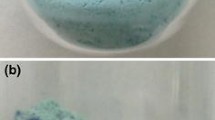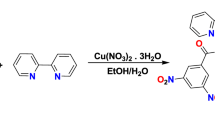Abstract
Thermal decomposition of a mixed valence copper salt, Na4[Cu(NH3)4][Cu(S2O3)2]2·0.5NH3 (1) prepared from pentahydrates of sodium thiosulfate and copper sulphate of various molar ratios in 1:1 v/v aqueous ammonia solution, has been studied up to 1,000 °C in flowing air by simultaneous thermogravimetric and differential thermal analysis coupled online with quadrupole mass spectrometer (TG/DTA-MS) and FTIR spectrometric gas cell (TG-FTIR), in comparison. Compound 1 releases first but very slowly some of the included ammonia till 170 °C, then simultaneously ammonia (NH3) and sulphur dioxide (SO2) from 175 to 225 °C, whilst the evolution of SO2 from thiosulfate ligands continues in several overlapping stages until 410 °C, and is escorted by explicit exothermic heat effects at around 237, 260, 358 and 410 °C. The former two exothermic DTA-peaks correspond to the simultaneous degradation and air oxidation processes of excess thiosulfate anions not reacted by formation of copper sulfides (both digenite, Cu1.8S and covellite, CuS, checked by XRD) and sodium sulfate, while the last two exothermic peaks are accompanied also by considerable mass gains, as the result of two-step oxidation of copper sulfides into various oxosulfates. The mass increase continues further on until 580 °C, when the sample mass begins to decrease slowly, as a continuous decomposition of the intermediate copper oxosulfates, indicated also by re-evolution of SO2. At 1,000 °C, a residual mass value of 64.3% represents a stoichiometric formation of CuIIO and anhydrous Na2SO4.




Similar content being viewed by others
References
Aylmore MG, Muir DM. Thiosulfate leaching of gold – a review. Miner Eng. 2001;14:135–74, and references therein.
Umetsu Y, Tosawa K. Dissolution of gold in ammoniacal sodium thiosulfate solution. Bull Res Inst Miner Dress Metall. 1972;28:15, and references therein.
Rábai G, Epstein IR. Series systematic design of chemical oscillators. 83. Equilibria and kinetics of the fast interaction between copper(II) and thiosulfate ions in aqueous solution. Inorg Chem. 1992;31:3239–42.
Ferrari A, Braibanti A, Tiripicchio A. The crystal structure of tetrasodium tetraamminecopper(II) di-catena-di-μ-thiosulphato-cuprate(I). Acta Crystallogr. 1966;21:605–10.
Morosin B, Larson AC. The crystal structures of copper tetrammine complexes, B. Na4[Cu(NH3)4][Cu(S2O3)2]2·NH3. Acta Crystallogr B. 1969;B25:1417–9.
Hathaway BJ, Stephens F. The electronic properties and crystal structure of Na4[Cu(NH3)4][Cu(S2O3)2]2·L (L = H2O or NH3). J Chem Soc A. 1970;6:884–8.
Tomlinson AAG, Hathaway BJ, Billing DE, Nichols P. Electronic properties and stereochemistry of the copper(II) ion. V. Tetra-ammine complexes. J Chem Soc A. 1969;1:65–71.
Drake RF, Hatfield WE. Magnetic studies of tetrasodium tetraamminecopper(II) di-catena-di-μ-thiosulfatocuprate(I) monoammoniate. J Inorg Nucl Chem. 1974;36:2489–91.
Newman GA. Infrared spectra of tetrasodium tetrammine copper(II) dicatena-di-μ-thiosulfato-cuprate(I) and related complexes. J Mol Struct. 1970;5:61–6.
Gabelica Z. Reexamination of the infrared spectra of complex thiosulfates of the type Reexamination of the infrared spectra of complex thiosulfates of the type Na4[MII(NH3)4][MI(S2O3)2]2·L (MII = Cu, Ni; MI = Cu, Ag; L = H2O, NH3). Ann Soc Sci Brux. 1977;91:243–54.
NIST Chemistry Webbook Standard Reference Database No 69, June 2009 Release, (http://webbook.nist.gov/chemistry).
Madarász J, Pokol G. Comparative evolved gas analyses on thermal degradation of thiourea by coupled TG-FTIR and TG/DTA-MS instruments. J Therm Anal Calorim. 2007;88:329–36.
Inorganic Crystal Structure Database (ICSD), Fachinformationszentrum Karlsruhe (FIZ) and National Institute of Standards and Technology (NIST), Version Release 2008/1.
International Centre for Diffraction Data (ICDD), Powder Diffraction File (PDF), PDF-2 Release 2007.
Bombicz P, Madarász J, Forizs E, Foch I. Structure and thermal behaviour of (SPY-5-12)-(2-aminoethanol-N)-(2-aminoethanol-N,O)bis(theophyllinato)copper(II) dihydrate, a model for DNA-metal interactions. Polyhedron. 1997;16:3601–7.
Madarász J, Okuya M, Kaneko S. Preparation of covellite and digenite thin films by an intermittent spray pyrolysis deposition method. J Eur Cer Soc. 2001;21:2113–6.
Madarász J, Bombicz P, Okuya M, Kaneko S. Thermal decomposition of thiourea complexes of Cu(I), Zn(II), and Sn(II) chlorides as precursors for the spray pyrolysis deposition of sulfide thin films. Solid State Ionics. 2001;141–142:439–46.
Krunks M, Leskelä T, Mannonen R, Niinistö L. Thermal decomposition of copper(I) thiocarbamide chloride hemihydrate. J Therm Anal Calorim. 1998;53:355–64.
Krunks M, Leskelä T, Mutikainen I, Niinistö L. Thermoanalytical study of copper(I) thiocarbamide compounds. J Therm Anal Calorim. 1999;56:479–84.
Dunn JG, Muzenda C. Thermal oxidation of covellite (CuS). Thermochim Acta. 2001;369:117–23.
Dunn JG, Muzenda C. Quantitative analysis of phases formed during the oxidation of covellite (CuS). J Therm Anal Calorim. 2001;64:1241–6.
Zivkovic Z, Strbac N, Zivkovic D, Velinovski V, Mihajlovic I. Kinetic study and mechanism of chalcocite and covellite oxidation process. J Therm Anal Calorim. 2005;79:715–20.
Simonescu CM, Teodorescu VS, Carp O, Patron L, Capatina C. Thermal behaviour of CuS (covellite) obtained from copper-thiosulfate system. J Therm Anal Calorim. 2007;88:71–6.
Shan J, Pukkinen P, Vainio U, Maijala J, Jiang H, Serimaa R, et al. Synthesis and characterization of copper sulfide nanocrystallites with low sintering temperatures. J Mater Chem. 2008;18:3200–8.
Patron L, Carp O, Mindru I, Pascu M, Stanica N, Ciupina V, Segal E, Brezeanu M. Two novel copper coordination compounds with thiosulfate anions as ligands. J Therm Anal Calorim. 2003;72:271–279.
Acknowledgements
The purchase of our new HT-XRD apparatus has been supported by the EU (GVOP-3.2.1.-2004-04-0224, KMA) and Hungarian Government, what is gratefully thanked. The authors thank also Oana Carp (Roumanian Academy, Institute of Physical Chemistry Ilie Murgulescu) for bringing the Cu(II) - thiosulfate system [25] into the focus of attention.
Author information
Authors and Affiliations
Corresponding author
Rights and permissions
About this article
Cite this article
Madarász, J. Evolved gas analyses on a mixed valence copper(I,II) complex salt with thiosulfate and ammonia by in situ TG-EGA-FTIR and TG/DTA-EGA-MS. J Therm Anal Calorim 97, 111–116 (2009). https://doi.org/10.1007/s10973-009-0236-8
Published:
Issue Date:
DOI: https://doi.org/10.1007/s10973-009-0236-8




